Knitting, copyrights, and copyleft
I should warn you from the outset that this is somewhat of a long post.
I’m Alex, previously known on the site as “the nice fellow engaged to Ellen,” and “the guy who does the computer stuff.” In my little job of filling in while Ellen is enjoying some fun-in-the-sun, I thought it might be fun to write a Russian novel little bit about the advantages and disadvantages of copyleft licenses as applied to knitting. Many of the knitters I have talked with seemed to have an ambivalent relationship with copyright issues—they know they aren’t supposed to make photocopies from their knitting books to give to others (but do it anyways), and are always quick to stamp a copyright notice on their own patterns—and it seems like this might be a good way to talk about copyright issues in an environment other than “things you are not allowed to do and should feel guilty that you in fact do.”
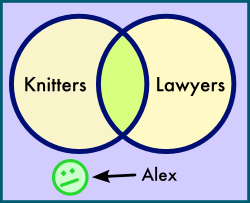 |
| There are knitters, there are lawyers, there are lawyers who are knitters, and then, somewhere else, is Alex. |
First things first: though Ellen finds me quite adorable, I am, in fact, not a knitter. I’m in fact fairly ignorant of the nuts and bolts of the craft (all I know is that it involves needles, yarn, and cursing) and despite Ellen’s attempts to “educate” me about it, I somehow remain more-or-less clueless. Alas, we all have faults.
Another strike against me (or perhaps a benefit?) is that I’m not a lawyer, and this is not legal advice. I’d make a lawyer joke here but I know my father (who is a lawyer), could probably think of a much better one.
To my credit, I am a graduate student, and I have done some reading (and writing) on intellectual property issues, and gone to conferences and heard “experts” debate amongst themselves on these things. As one scribe has said, “I ain’t passed the bar, but I know a lil’ bit.” On that note, I’ll end with the introductions and get into the meat of it…
(One last disclaimer: my knowledge of copyright law extends only as far as the United States borders. I have no idea if any of this would make sense applied internationally. Much of it should… but in any case, I don’t know for sure.)
Copyrights and copylefts
Copyrights are, philosophically speaking, supposed to be temporary monopolies given to people over their creative and expressive works. They are meant to reward authors (of any sort of creative work) with the ability to legally control the fruits of their creativity within the economic marketplace. I don’t think there’s anything too terribly wrong with that in an abstract sense—people who produce creative works, whether they be books, poems, music, photographs, paintings, computer programs, or, say, knitting patterns, should have the ability to make a few dollars off of their hard work.
However copyrights aren’t given out just because someone deserves them. Intellectual property laws are usually based in the idea that if you give creators protection over their creations, it will encourage them to make the creation in the first place. Some artists are happy slaving away in poverty, but I’ll bet that even they get tired of wearing cheap shoes. Copyrights are given to expressive works, and patents are given in the case of inventions.
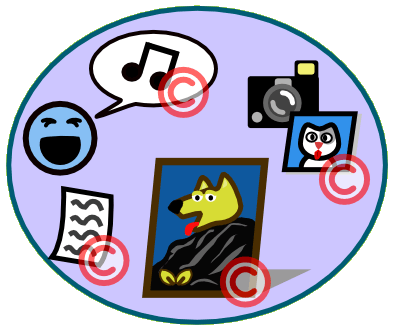 |
| Copyrights are limited monopolies given to expressive works of all forms. Just about anything creative automatically generates copyright protections. |
But the tension between intellectual property being used to stimulate production on the one hand, and it being used to inhibit production on the other, has been there from the beginning. Just as the patent system can be used to encourage companies to invest in expensive research and development, it can just as easily—perhaps easier, depending on the legal circumstances—be used to push competitors out of business. Copyrights, which can (depending on the technicalities) remain legally in force a hundred years longer than patents can, have become synonymous with legal prohibition of expressive work in many people’s minds: those little circled-C’s mean “Hands off! Beware! Don’t copy or misuse or do anything with this that I don’t approve, or I’ll sue!”
The approach of the free content movement—the copyleft people—has been to try to encourage copyright practices which allow great freedom for innovation and collaboration, but also offer the author certain controls over their work as well. The essence of it is that most people really don’t need to have “all rights reserved”—they can give away substantially more rights, if done carefully, and won’t suffer any negative consequences (that is, they can still make a buck off of their work). While it is clear that Disney isn’t going to want to do this anytime soon, most content producers are, thankfully, not Disney. This granting of additional rights is done through the use of licenses.
How licenses work
Every time someone uses copyrighted material with the permission of the copyright holder, they are doing it under a license. In other words, a license is basically the terms by which a copyright holder allows others to use their copyrighted works. The copyright holder cannot dictate all of the terms of use—certain uses are deemed “fair use” under U.S. copyright law and can be done without the permission of the copyright holder without being copyright infringement—but they have a pretty broad leeway.
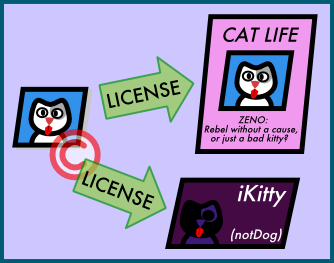 |
| Licenses are what allow copyrighted works to be used by others, and to be used in derivative works. They are agreements between the copyright holder and the user of the material. |
Whenever you see a note at the bottom of a knitting pattern that says “not for commercial use,” that’s a license agreement, where the copyright holder is saying, “You can use this for any use that isn’t for commercial profit.” There are other types of things it could say as well, the most restrictive being something like “All rights reserved,” which is a legal way of saying, “Don’t even think about doing something with this other than purchase it and enjoy it for yourself.”
Copyleft licenses attempt to open up this combative atmosphere between content produce and content consumer by spelling out usage terms ahead of time and often in very specific legal code. The exact content of the licenses—and how comprehensible they will be to a non-legal eagle—can vary widely. Some, like the Free Software Foundation’s GNU Free Documentation License (originally meant for use with software manuals, but now used very widely) are complicated and almost-incomprehensible legal documents. Others, like the Creative Commons licenses, come with “human readable” versions as well as their “full legal” versions.
I’m going to use the Creative Commons (CC) licenses here as my examples because they are the most flexible, the easiest to understand, and are rapidly gaining influence. Unfortunately some of that flexibility means that you can use CC licenses in very non-“free” ways, but even then they are probably better than traditional copyright claims. Free, in the sense of “free content,” does not mean gratis, or “without cost,” but rather it is used in the sense of libre, or “freedom,” in the sense that they are not restrictive. Unfortunately in English these two very different meanings are kept in the same word, which can lead to some confusion. The computer people like to say “free as in speech, not as in beer,” but I think this just reinforces the stereotype that these people have no ear for language.
Creative Commons licenses are modular—you can pick and choose properties and create custom-fitting licenses for your needs. For example, one “module” you can have incorporated into your license is one which requires “attribution” of the work. In effect, it is a requirement that says, “Whatever you do with this piece of copyrighted material, you need to always credit me (or someone else) in the following manner.” Yes, you could just write that on something you produced without a CC license, but the CC license also says that in complicated legalspeak as well.
Another one of the “modules” is one which says, “This copyrighted material cannot be used for commercial purposes.” I don’t think this is actually as good idea as it usually sounds to most people—for many people the idea of “non-profit” has an allure of purity around it, but in practice many good things are technically “for profit” and the goals of a restriction like this (to avoid exploitation) can be accomplished by other means—but it is a good example of how these modules work. You could combine the two I’ve mentioned already, and have a license which permits any use of a piece of copyrighted material as long as it is not-for-profit and carries a certain by-line on it.
My least favorite “module” is one which says that no derivative works can be made with the copyrighted material. This is decidedly not free and should probably not be used in most situations—it almost defeats the purpose, in my opinion, since almost any use can be considered derivative (there are a few specific exceptions and clarifications laid out in the license, but nonetheless it is a bad condition).
My most favorite “module” is one they call “ShareAlike.” This is a feature in most free content licenses, and is usually the one which sets them apart from any other sorts of licenses in that they are viral (don’t worry, you can’t catch a cold from it). This means that if someone uses the material to make a derivative work (say, to use your short story along with others to make a collection of short stories), then the derivative work must be released under the same free license as your material was.
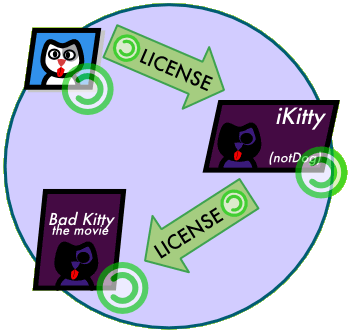 |
| Viral licenses make it so that any derivative works of copyleft licenses are also copyleft. This not only keeps copyleft material free, it also makes it less likely that big-time copyright producers will want to use copyleft material, so there is a low chance of exploitation. |
What this means it that the “freedom” can’t just be ended, and instead attempts to perpetuate itself indefinitely. Disney couldn’t take your story, use it in their own work, and then try to prosecute people for infringing on the derivative work. It is a very clever concept: Sure, you say, you can use my photograph in your collage. But you have to make it so that other people can use their collage if they want to, under the same permissive terms. Aside from making sure that free material stays free, this has other more practical effects as well, which I’ll get to in just a second when I apply this directly to knitting.
This doesn’t mean, though, that you can’t separately license your material later. For example, if I took a picture and released it under a free license, I could, if someone wanted to use it in a non-free collection, re-license it under different terms with them. The original picture and license would still hold (I couldn’t sue anybody for using it under those terms, that is), but I, as the content producer, would not be locked in to only allowing it to be used under a viral license.
Knitting and copyleft: How would is work? What is to gain? What is to lose?
So what does this amount to for knitters? First we have to consider what copyrights mean to knitting usually. For published books of knitting patterns, it often just means “don’t photocopy this except for your own personal use, and don’t use it as a basis for your own work.” For free patterns on the internet, it usually means, “you can make copies of this for others, but you can’t make any money off of it, and you can’t change the contents at all.” For the knitted designs themselves, it is usually (from what I can tell) implicitly understood by knitters to mean “don’t copy someone else’s design directly.”
There are often other conditions for the license, ones I admittedly don’t quite understand the purpose of, such as “don’t donate any finished products resulting from this to charity.” I have a feeling this is related to the complicated status of authorship in knitting—is a finished pair of socks the product of the designer or the knitter?—rather than a case of people desperately wanting to donate a $70 pair of socks to a shelter or people desperately wanting to stop them from doing so. This question of authorship is, I think, an important one that comes up in every craft, where it is clear that while the designer has a very important role to play, the actual execution of the design (with its color choices, its adaptations, its little fixes and changes, and its own struggle) cannot be said to be without authorship either (it is not “slavish copying,” which is one legal way to discuss a lack of authorship rights).
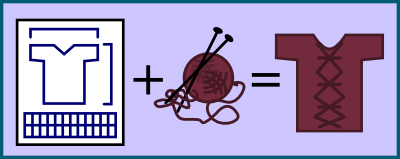 |
| A final knitted garment is the combination of the creativity and skill of the designer with the creativity and skill of the knitter. The current method of dealing in copyrights in knitting primarily respect only the authorship of the designer, however. |
So what is to gain by using copyleft licenses rather than traditional copyright warnings? Well, for one thing, it would potentially open up the atmosphere for more collaboration. Want to use someone else’s scarf motif on the sleeves of your sweater design? No (legal) sweat if the scarf design is under a free license. Want to distribute 20 copies of a pattern to your knitting group? Again, not an issue if it is under a free license.
If the licenses were sufficiently free (that is, they did not prohibit derivative works and did not prohibit non-commercial use) then you could even imagine taking a handful of copyleft patterns and putting them into a beautiful book and selling them. But notice, you wouldn’t be selling the intellectual property of the book—just the material (paper, ink, binding) and the labor. Since the book itself would have to be licensed under a free license, you wouldn’t be able to make money just by the fact of copyright alone—someone else could easily come along and make their own copies of the same book and sell them for themselves. In economic terms, this would mean that to use this for profit purposes would require extra value other than the intellectual property alone—what would make your book better than someone else’s with similar content might be the good paper you have printed it on, or the sample yarn you attach with it, or simply the fact that it comes from you, in some cases.
For big-time design producers, this probably looks like heresy. “Someone could make a book out of my patterns without my permission, much less without paying me? Yarn stores could give away free copies? Ack!” The big fear in most people’s minds when they read things like this is “the Disney fear”: a mega-corporation will come along, take your work, and turn it into a million-dollar blockbuster, and you’ll still be stuck in your shabby house.
In practice, this doesn’t happen — Disney makes their money from their intellectual property rights, and would never consent to releasing their work under a free license, and as such would never use a viral license.
Even if they did, though, that wouldn’t necessarily be the end of the world: they’d still be required to give credit to you, and credit is worth a lot in this world. OK, so Disney doesn’t pay you much for this film, but now that your name is out there it’ll definitely help you find work on your next film.
Which is a round-about way of saying that copyleft licenses are probably best for small-time producers, not big-business ones. They allow you to give away a lot, to get your name out there, and allow collaboration, with a few checks in place to avoid getting exploited.
The other advantage to the copyleft licenses is that one could also see them as being more respectful of the work that goes into actually creating the finished garment. Rather than being in the role of “the person who does what the designer tells them,” it could help to acknowledge—in terms of credit and authorship—that the translation from pattern to finished product is itself a creative and collaborative event, and the final product is really the work of at least two people, not just one.
Under a truly free license (i.e. one that did not contain “non-commercial” specifications”), a knitter would also be free to sell their finished products, as long as they gave credit where credit was due. I am sure that knitters would have varied opinions on the value of this, but it strikes me as strange that designers have used intellectual property claims as a way of restricting this sort of behavior. No doubt they fear the Disney situation (someone making money off of their hard work), but again, I not only find that unlikely to occur, but I think it fails to recognize that more than one person is doing the hard work in such a situation.
Conclusions: little to lose, much to gain?
In the knitting world, the small designer has very little to lose by using free licenses on some of their patterns. At the very worst they will get lots of exposure which they can then turn around later for other things. At the very best, it could foster a freer attitude towards knitting and designing, allow for stress-free collaborations and derivative works, and potentially present an alternative model for craft from its guild-like, protective past. Somewhere in between those extremes, the use of standardized licenses could also make copyright issues less ambiguous than they currently are. The goal of copyleft is to try and restore that balance between creativity and restriction, and attempts to do so by encouraging practices which would result in more collaboration and creation of content while preserving important aspects of authorial control used in traditional copyrights.
I apologize for being so long-winded about things here (Damn it, Jim, I’m an academic, not a blogger!), and hope that at the very least this might have provoked a greater awareness of copyrights as they apply to knitting, the goals of the copyleft advocates, and perhaps some food-for-thought about the idea of authorship. I’d be very interested in the response of knitters to these ideas (you can e-mail me at: alex [at] atomland-on-mars [dot] com, if you’d like), in part because it is a craft product (and somewhat different in that sense than most of the copyright situations which come up in copyleft discussions), and because I get most of my own understanding of knitting second-hand. I don’t think knitters have much to lose by using copyleft licenses, and could potentially have a lot to gain.
Some useful copyright links
I thought that while I was already writing a post long enough to make a Russian novelist blush (perhaps today we should call the blog The Nyet Sisters), I would post a few useful links for people interested in copyright issues in general. The first is a book which I recommend to anyone interested in copyright and copyleft issues, Lawrence Lessig‘s book Free Culture: How Big Media Uses Technology and the Law to Lock Down Culture and Creativity. Though the subtitle sounds a little conspiratorial, Lessig’s book is a very good intro to the history of copyright issues, the ways in which copyright has been used to stifle small creators, and is something of a rallying cry for the free content movement. Definitely worth a read, and it is a very accessible read at that, for a book on copyright law. Oh, and it’s available free online, which makes it even more exciting (if you are happy with reading a book on your computer, of course).
The next link is Stanford Copyright and Fair Use Center. I didn’t talk about fair use much in this article but if you are wondering about how much use counts as “fair use” under U.S. copyright law, this website is a great primer to “fair use” determination and gives lots of examples of relevant case law (which is, in the end, the best determination for fair use one has, outside of a court, which is not where you want to be).
And last is a somewhat useful Copyright FAQ for Knitters. This is concerned primarily with the questions of photocopying patterns (generally speaking, no, because they are under restrictive copyrights, boo). I find pages like this somewhat depressing reads, as they reflect the almost purely restrictive way that copyright is used today, but knowing about those restrictions is important (especially if you want to dream about alternatives).
August 2nd, 2006 at 2:55 pm
Hi Alex,
We learned in apparel school that if you change a design or pattern by 10% or more, it is no longer covered by copyright. Not sure if it’s the same for knitting, though. Sad, but true.
As far as apparel with logos, that’s another story. The logo is either TM or copyrighted, and is illegal to use. That’s why fake designer purses are illegal, but knock-off clothing (without labels/logos) are not.
🙂 Jill
http://gelsominalucchesi.blogspot.com
August 2nd, 2006 at 4:04 pm
That sounds more like a “rule of thumb” than any strict legal determination (courts never get you definite numbers or percentages for things like this—sometimes three paragraphs is copyright infringement, sometimes you can copy half a book and not have it be a problem), but it is really interesting that they teach it in this way. I think the real kicker in the case of apparel would be how one defines 10% worth of “change” (does changing the color count as 1%, 10%, 20%, 0%?).
Trademarks are an entirely different story, you’re absolutely right. They never expire unless they stop being maintained, which makes sense (trademark protection is not intended to help stimulate competition, but to avoid fraud issues). Generally speaking people should not mess around with other people’s trademarks as it is a real minefield (even logos of universities on privately produced items have led to legal difficulties for people in the past).
August 4th, 2006 at 7:55 am
Wow, Alex. Thanks. I’m going to have to read this again and again. Nicely done!
August 6th, 2006 at 10:00 am
Very nicely written article, I have bookmarked it for future reference.
Thanks for the links, and the summaries of how Copyright and Copylefts work. I recently got a CC license for my blog, and this article greatly helps me understand it.
Thanks. 🙂
August 31st, 2006 at 7:56 pm
Thank you very much for replying to my copyleft article in my blog ^^ I read through this and much better understand what’s going on here. I think I’ma edit a link to this article into my post and also look to change my copyleft up some; thanks a lot!
~LAEvanesce
July 31st, 2007 at 3:03 pm
You should have made the lawyer joke when you had the chance!
March 15th, 2008 at 2:10 am
Great article – thank you!